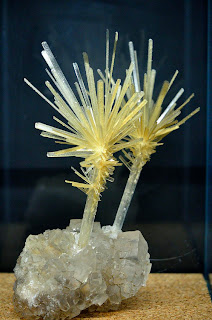According to geologists at the University of Toronto and the University of Maryland some of the rocks beneath earths surface maybe from space. James Brenan, of the Department of Geology at the University of Toronto, says "The extreme temperature at which the Earth's core formed more than four billion years ago would have completely stripped any precious metals from the rocky crust and deposited them in the core."
So far the current results say that there is no way that mine-able platinum and rhodium would exist from just
internal processes alone, and the only way is they could exist is a 'rain' of extraterrestrial debris spreading the rar minerals over the surface of earth. The resurch was funded with the support of the Natural Sciences and Engineering Research Council of Canada and a NASA Cosmochemistry grant. And you can read the full article here: http://www.sciencedaily.com/releases/2009/10/091018141608.htm
It would be really interesting if most of our rare minerals came from outer space. And it would explain somewhat why these minerals are so rare and how they only happen in some areas even though the same conditions can occur somewhere else and not have the mineral come out.
Awesome Geology!
Tuesday, April 2, 2013
Really interesting story about how the AVO has been monitoring Alaskan Volcanoes for 25 years. They mainly monitor them because of the crash that was avoided in 1989. And It talks about how "Throughout the years, AVO and its colleagues developed innovative ways to track earthquake activity, ground deformation, and volcanic gas output, and analyze satellite imagery in the harsh Alaskan environment." which is pretty awesome
Read the article here: http://www.usgs.gov/newsroom/article.asp?ID=3542&from=rss#.UVr_KpPviSo
Read the article here: http://www.usgs.gov/newsroom/article.asp?ID=3542&from=rss#.UVr_KpPviSo
A wonderful Picture of two Halite crystals. Halite is also known as rock salt because it is the mineral version of NaCl. It usually occurs when vast beds of sedimentary evaporate. For more pictures of minerals go to (http://www.flickr.com/photos/31223088@N08/8476240063/in/pool-97068393@N00) and for more about Halite go to (http://en.wikipedia.org/wiki/Halite)
Radio Interview
Interesting radio interview from Stanford. Climate scientist Ken Caldeira talks about geoenginiering and some really funny stories about him dealing with climate change skeptics http://www.stanford.edu/group/anthropocene/cgi-bin/wordpress/the-mad-science-of-geoengineering/?utm_source=rss&utm_medium=rss&utm_campaign=the-mad-science-of-geoengineering
MINERAL TIME!
A group of metalic fibers of Jamesonite. Jamesonite is a sulfosalt mineral, a lead, iron, antimony sulfide with formula Pb4FeSb6S14 . For more information on Jamesonite go to ( http://en.wikipedia.org/wiki/Jamesonite )
Interesting story about how 28 thousand rivers have disappeared off the state water maps in China.
http://suvratk.blogspot.com/2013/04/huh-thousands-of-rivers-wiped-off-map.html?utm_source=feedburner&utm_medium=feed&utm_campaign=Feed%3A+ReportingOnARevolution+%28Reporting+on+a+Revolution%29
http://suvratk.blogspot.com/2013/04/huh-thousands-of-rivers-wiped-off-map.html?utm_source=feedburner&utm_medium=feed&utm_campaign=Feed%3A+ReportingOnARevolution+%28Reporting+on+a+Revolution%29
Tuesday, January 22, 2013
Mineral Time!
Mineral: Biotite
Like other mica minerals, biotite has a highly perfect basal cleavage, and consists of flexible sheets, or lamellae, which easily flake off. It has amonoclinic crystal system, with tabular to prismatic crystals with an obvious pinacoid termination. It has four prism faces and two pinacoid faces to form a pseudohexagonal crystal. Although not easily seen because of the cleavage and sheets, fracture is uneven. It appears greenish to brown or black, and even yellow when weathered. It can be transparent to opaque, has a vitreous to pearly luster, and a grey-white streak. When biotite is found in large chunks, they are called “books” because it resembles a book with pages of many sheets.
Under cross-polarized light biotite can generally be identified by the gnarled bird's eye extinction.
(Words From http://en.wikipedia.org/wiki/Biotite )
(Picture From http://wannenkopfe.strahlen.org/biotite13.html )
Subscribe to:
Posts (Atom)



